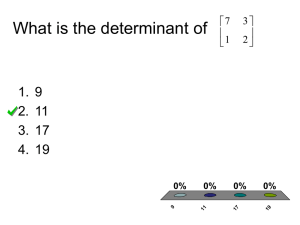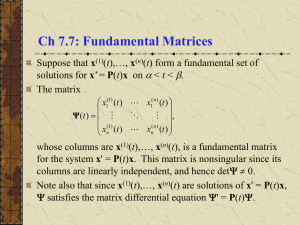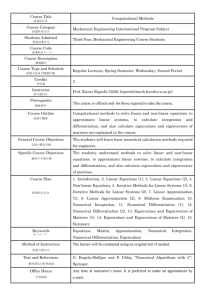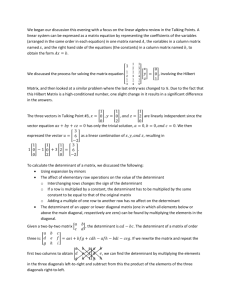Eigenvalues_and_Eigenvectors_W2003
advertisement
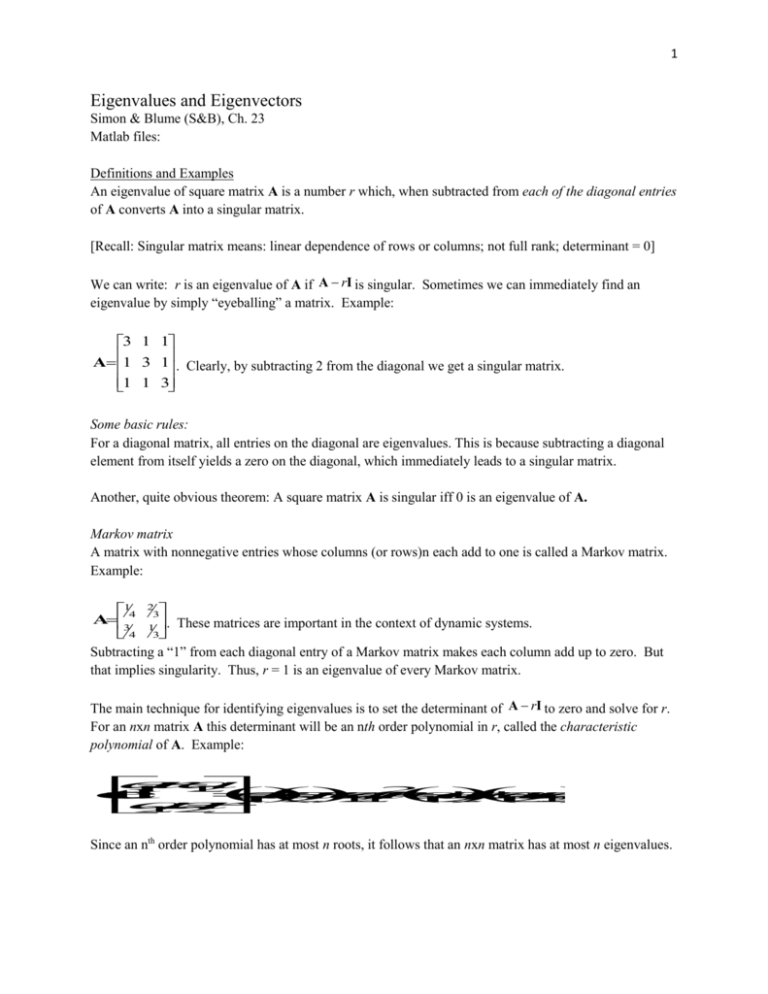
1 Eigenvalues and Eigenvectors Simon & Blume (S&B), Ch. 23 Matlab files: Definitions and Examples An eigenvalue of square matrix A is a number r which, when subtracted from each of the diagonal entries of A converts A into a singular matrix. [Recall: Singular matrix means: linear dependence of rows or columns; not full rank; determinant = 0] We can write: r is an eigenvalue of A if A rI is singular. Sometimes we can immediately find an eigenvalue by simply “eyeballing” a matrix. Example: 3 1 1 A 1 3 1 . Clearly, by subtracting 2 from the diagonal we get a singular matrix. 1 1 3 Some basic rules: For a diagonal matrix, all entries on the diagonal are eigenvalues. This is because subtracting a diagonal element from itself yields a zero on the diagonal, which immediately leads to a singular matrix. Another, quite obvious theorem: A square matrix A is singular iff 0 is an eigenvalue of A. Markov matrix A matrix with nonnegative entries whose columns (or rows)n each add to one is called a Markov matrix. Example: 14 23 A . These matrices are important in the context of dynamic systems. 3 4 13 Subtracting a “1” from each diagonal entry of a Markov matrix makes each column add up to zero. But that implies singularity. Thus, r = 1 is an eigenvalue of every Markov matrix. The main technique for identifying eigenvalues is to set the determinant of A rI to zero and solve for r. For an nxn matrix A this determinant will be an nth order polynomial in r, called the characteristic polynomial of A. Example: a r a 1 1 1 2 2 d e t a r a r a a r a a r a a a a 1 12 2 1 2 2 1 1 1 2 21 1 2 2 1 2 2 1 a a r 2 1 2 2 Since an nth order polynomial has at most n roots, it follows that an nxn matrix has at most n eigenvalues. 2 Eigenvectors Recall that a square matrix B is nonsingular iff the only solution of Bx 0 is x 0 . Conversely, B is singular iff there exists a nonzero x s.t. Bx 0 . Examples: Not singular: 12 B 01 x 1 x x 2 x 2 x 1 2 B x 0 x 0 ,x 0 , 1 2 x 2 Singular: 12 B 24 B 1 x 1 x x 2 2 x x 1 2 B x 0 x 2 ,x 1 , B 0 1 2 2 x 4 x 1 2 It follows that if r is an eigenvalue of the square matrix A, the system of equations ArIc0has a solution other than c 0 . Such a vector c is called the eigenvector of A corresponding to the eigenvalue r. We can write: A c r I c 0 A cr c For examples of finding eigenvalues and eigenvectors see S&B, p. 583. For a given eigenvalue, there usually exists an infinite set of eigenvectors. They form what’s called the eigenspace of A w.r.t. a given eigenvalue. Solving Linear Difference Equations Eigenvalues and eigenvectors can be useful in solving k-dimensional dynamical problems modeled with linear difference equations. To warm-up, let’s look at such an equation in k = 1 dimension: yt 1 ayt for some constant a. An example would be an interest-accumulating account with yt11yt where is the interest rate. A solution to this difference (or dynamic) equation is an expression for yt in terms of the initial amount y0 , a, and t. In this case, we can find the solution via recursive substitution: 3 y1 ay0 y2 ay1 a 2 y0 yt at y0 Now consider a system of two linear difference equations with cross-dependence (i.e. the equations are coupled): xt1 axt byt yt1 cxt dyt In matrix form, this can be written as x x ab t 1 t z A z t + 1 t y y c d t 1 t If b = c = 0 the two equations become uncoupled, and can be easily solved: t x a x x a x t 1 t t 0 t y d y y a y t 1 t t 0 When the equations are coupled, the system can be solved by first finding a change of variables that uncouples them. S&B provide a concrete example (p. 588) of this technique. We’ll jump right into the abstract (i.e. general) case. Consider the following two-dimensional system of difference equations: zt+1 Azt Assume there exists a 2x2 non-singular, invertible “change-of-coordinate” matrix C s.t. z C Z , 1 Z C z and 1 1 1 1 1 Z C z C A z C A z C A C Z C A C Z t + 1 t + 1 t t t t -1 Now, if C AC were a diagonal matrix the transformed system of difference equations would be uncoupled and thus easily solved. So the question becomes: What kind of matrix C will lead to a -1 diagonal C AC ? 4 Partition C into its columns, i.e write C as Cc1 c2, and let the desired diagonal matrix be generically expressed as r 0 -1 Λ 1 . Thus, we want C ACΛ, or, equivalently, AC CΛ. We can write this as 0 r 2 r 10 A c c A c c r cc 1c 2 1c 2 1A 2 1 1r 2 2 0 r 2 A cc r A c r c 1 1 1 2 2 2 Thus, we want r1 and r2 to be the eigenvalues of A, and c1 and c 2 the corresponding eigenvectors. k-dimensional system Now let A be a k by k matrix, r1 through rk its eigenvalues, and c1 through ck the corresponding eigenvectors. Then r 1 CA C 0 -1 0 Λ r k Generally, if the above holds, the columns of C must be the eigenvectors of A and the diagonal entries of Λ must be its eigenvalues. We can also write ACΛC-1 , which is the spectral decomposition of A. (See matrix algebra tutorial notes for more details). Note: Since there exist an infinite number of eigenvectors for each eigenvalue, it is standard procedure to normalize each column in C s.t. cc 1 (Matlab’s eig command does this automatically) Now we have the tools to solve a general linear system of difference equations zt+1 Azt . If the eigenvalues of A are real and distinct, and if we construct C as a matrix of eigenvectors of A, the linear change of variables z CZ transforms the system of difference equations to the uncoupled system 1 Z A C C ZΛ t + 1 tZ t which we can easily solve as 5 Z 1 , t 1 r1 t Z 2 , t 2 r 2t Z k , t k r kt where the -terms are constants that are implicitly defined by the initial conditions for zj , j 1 k. Transforming back to the original variables yields z Z 1 , t 1 , t z Z 2 , t 2 , t z C cc t 1 2 z Z k , t k , t t r 1 1 t r t t t 2 2 c r c r c r c k 1 1 2 2 2 k k k 1 t r k k z Now all we need to complete the solution is knowledge of the initial vector z 0 1 , 0 z 2 , 0 Then, setting t = 0 in yields z c c c cc 0 1 1 2 2 k k 1 2 z k , 0 . 1 1 2 2 c C . k k k Thus, by proper choice of the terms gives the solution of zt+1 Azt for any z 0 . Thus, is often referred to as the general solution of zt+1 Azt . The solution to this system can also be derived via matrix powers (see p. 594-5). If we have C-1ACΛ, then the t-th power of matrix A can be expressed as t r 1 t A C 0 0 -1 C t rk And the solution to the system of difference equations with initial condition z 0 can be expressed as t r 1 t z A z C t 0 0 0 -1 C z 0 t r k 6 Stability of equilibria t If z 0 0 then the solution of zt+1 Azt is zt 0 t , since A 0 0 for all t. A solution of the system in which z t is the same constant for all t is called a steady state, equilibrium, or stationary solution of the difference equation. The question arises as to the stability of the steady state solution zt 0 t . We declare this solution as asymptotically stable if every solution of zt+1 Azt tends to the steady state z 0 as t tends to infinity. Since gives every solution for different values of the terms, we conclude that every solution tends to t zero iff each ri tends to zero. Since the r-terms are eigenvalues of A and since they go to zero only if r 1 , we can state the following theorem: If the k by k matrix A has k distinct real eigenvalues, then every solution of the general system of linear difference equations tends to zero iff all eigenvalues of A satisfy r 1 .



